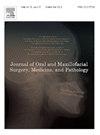Epstein–Barr virus-positive mucocutaneous ulcer arising in the oral region: A report of three cases and a review
IF 0.4
Q4 DENTISTRY, ORAL SURGERY & MEDICINE
Journal of Oral and Maxillofacial Surgery Medicine and Pathology
Pub Date : 2024-08-03
DOI:10.1016/j.ajoms.2024.07.011
引用次数: 0
Abstract
Epstein–Barr virus (EBV)-positive mucocutaneous ulcers (EBVMCUs) are localized mucosal or cutaneous ulcers caused by the proliferation of EBV-infected B cells in patients with immunosuppression. To reach an appropriate diagnosis of EBVMCUs, which have a favorable prognosis distinct from EBV-positive diffuse large B-cell lymphoma (EBV-positive DLBCL) with a poor prognosis, clinicopathological features of cases must be understood. Herein, we describe our experience with three cases of EBVMCUs in the oral cavity and review the literature. In case 1, a 56-year-old woman received methotrexate (MTX) and prednisolone for the treatment of psoriatic arthritis.After teeth extraction, ulcers formed, and bone exposure with necrotic-like tissues was observed. In case 2, a 73-year-old woman received MTX for the treatment of rheumatoid arthritis (RA). After tooth extraction, an ulcer was formed with bone exposure. In case 3, a 60-year-old woman received MTX for the treatment of RA. A well-defined ulcer was found on the left ventral surface of the tongue. All patients showed lesion resolution after MTX withdrawal. Since most EBVMCUs show a favorable prognosis distinct from EBV-positive DLBCL with a poor prognosis, an appropriate diagnosis is necessary.
求助全文
约1分钟内获得全文
求助全文
来源期刊

Journal of Oral and Maxillofacial Surgery Medicine and Pathology
DENTISTRY, ORAL SURGERY & MEDICINE-
CiteScore
0.80
自引率
0.00%
发文量
129
审稿时长
83 days
 求助内容:
求助内容: 应助结果提醒方式:
应助结果提醒方式:


